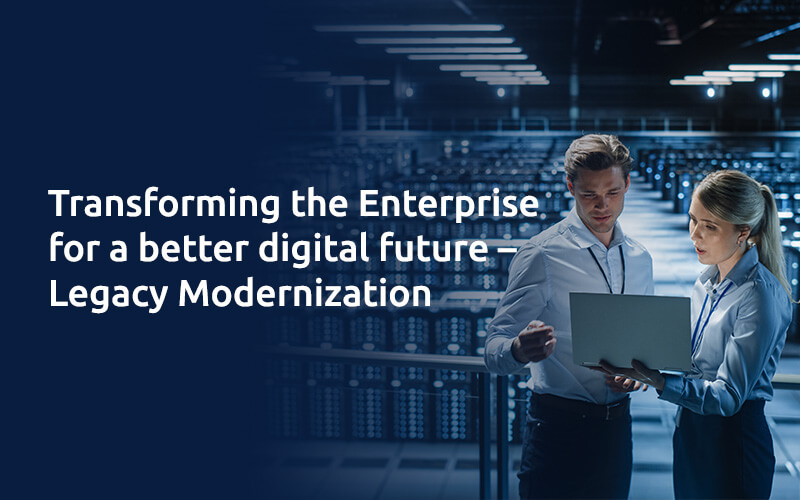
Transforming the Enterprise for a better digital future – Legacy Modernization
People get better with Age and Experience! Software Doesn’t!
Legacy modernization is the ongoing process of transforming legacy systems to reduce IT environment complexity and costs, increase data consistency, enable cross-platform collaboration, and improve process agility. Legacy modernization solutions help you modernize and migrate legacy systems to increase business agility, improve business responsiveness, reduce costs, and mitigate risk.
Understanding Legacy Systems
According to Gartner, legacy applications are “information systems that may be based on outdated technology, but are critical to day-to-day operations.” Examples of such legacy systems can be found in several large organizations. They use legacy applications running on old mainframes for core business operations such as processing large amounts of data. These systems have been refined and customized over the years to provide specific functionality. Legacy systems are not always defined by their age. A system may be considered a legacy system because it lacks support or is unable to meet the needs of your business or organization. Such software, because of its architecture, underlying technology, or design, is typically difficult (or impossible) to maintain, support, extend, or integrate with new systems.
Legacy systems require modernization, then why are they still working?
Of course this is a difficult choice but, there is a juncture to any organization where they need to take it;
-Operating outdated systems that have been tuned and adapted to functional requirements over many years to support mission-critical operations and gain a competitive advantage
OR
-Respond to increasing business pressures to be more agile, flexible and responsive by replacing technology that is struggling to keep up with the modern era
The global trends which are pushing for the modernization of Legacy systems,
Customer Expectations: Today’s customers expect highly personalized experiences and immediate responses. All forms of experience, good or bad, are shared on social media. This enables organizations to effectively understand and manage consumer needs and their experiences.
New Competition: Accelerating time-to-market for new products creates much more competition from established players with existing products, large companies trying to diversify into new product lines, and new start-ups. The cycle time from concept to production can no longer be ignored if companies want to maintain a competitive edge in the market.
Regulations: With new norms surrounding data security and governance, the protection/distribution of business information has become a new challenge for companies, especially those that operate across multiple countries.
Increased Demand & Improved Profits: Stakeholders are becoming increasingly aware of the end result. Growth is meaningless without profitability. This requires operational efficiency improvements, such as freeing up unnecessarily blocked capital to improve utilization.
Drivers for Modernization
Modern organizations face new challenges on all fronts. While there is constant pressure to minimize capital expenditures and make IT more efficient and agile, there is also the need to scale up or down based on business needs. Therefore, it is important to identify some of the key drivers of modernization and develop a plan for them.
1.TCO Reduction
Not only is the legacy system heavy on the application, but it consumes a lot of resources during maintenance. This leads to large capital outflows such as:
Operational costs driving up the total cost of ownership for a given application. Modernization helps organizations move to lightweight, open source, easy-to-use applications with enhanced functionality. This translates directly into an immediate reduction in capital investment. Additionally, the ability to consume resources through an “as a service” model translates capital costs into operational costs. This pay-as-you-go feature frees up a fixed investment that is often kept under-utilized only as a de-risking plan to handle peak loads for very limited periods of time.
2.IT Simplification
IT was once seen as a business enabler. So a lot of development/buying was done ad-hoc. Multiple silo-ed systems were established as information flow between different departments was restricted, as was visibility across the company. Most of the time, you can find multiple systems developed using different technologies performing the same function in different departments of your company. To make things even more complicated, most of these systems are forced together to achieve integration. As a result, various technology platforms became intertwined and struggled to ensure a seamless flow of information across the enterprise. But over time, IT has changed from a pure business enabler to a business driver. More and more organizations are basing their future strategies on IT. In such scenarios, their focus shifted to simplifying existing complex systems and removing bottlenecks through rationalization, standardization, and integration.
3.Risk Reduction
It’s no secret that legacy assets are becoming more and more expensive to maintain due to the continued exorbitant licensing costs and the rapid shortage of trained resources for legacy technologies. Also, aside from the frequently required extended planned outages for maintenance purposes, the risk of catastrophic failure is always present. Companies can no longer afford to ignore this aspect and take such significant risks to continue their business. Therefore, you should analyze your application landscape, identify systems that may harm critical business functions, and plan migration to safer and more cost-effective options.
4.Agility
As competition intensifies and customers expect faster response times, legacy systems pose a serious threat to an organization’s competitive advantage increases resistance to change.
Businesses must be able to react quickly to changing market dynamics. Flexibility and agility are therefore the virtues that today’s systems must possess. The inability of legacy to adapt to any type of architecture and operate with agility is a clear case of modernization
5.Growth and Enablement
IT must enable business growth. Rapid innovation is required as new channels emerge to reach consumers. Organizations are now outsourcing peripheral functions so they can focus more on their core competencies. Legacy modernization plays a key role in this. It frees up capital expenditures, converts needed new investments into operational cash outflows, and allows companies to reallocate more money to more critical areas such as research and development. It also accelerates concept testing and simulation, facilitates collaboration across regions and multiple stakeholders, and ultimately contributes significantly to profitable growth.
6.Standardization
When an organization splits or merges with another entity, it usually requires duplication/integration of the respective IT systems. Because organizations face inevitable change, it makes sense to adapt the IT portfolio to the new structure. In such cases, it is often possible to duplicate systems performing the same function (using the same or different technology) within the resulting organization. They also need to scale up or down based on new business needs. Modernizing legacy systems reduces the need to keep practicing cumbersome legacy technologies, enables smooth transitions, and promotes standardization between components.
The Right Modernization Solution
Organizations differ in business, process, and functional areas. Therefore, one solution does not fit all. In addition, the large number of products available from various ISVs makes choosing the best solution even more difficult.
Each option has its own strengths and weaknesses that should be evaluated in terms of the organization’s mission, vision, and future strategy. Score comparisons for the following parameters help determine the most appropriate solution.
Impact to Process Degree of impact to business process
Improved Business Functionality Improvement to existing functionalities
Improved User Experience Time required to train users to use new system
Migration Risk Overall risks in migration of one solution, databases and processes
Cost Outflow of cash for modernization
Exercise Timeline Time required to complete the modernization
Reuse of elements Usage of existing resources in the modernization platform
Skill-set Requirements Maintaining a skilled resource pool + Managed Services model
Legacy Dependency Left over legacy dependency post modernization
